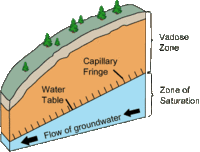Vadose zone

The vadose zone is like a big sponge underground. When water falls from the sky as rain, some of it soaks into the ground through the top layer of soil. This top layer of soil is called the vadose zone. The vadose zone is like the top of the sponge where it is dry. As water goes deeper into the ground, it enters the water table, which is like the bottom of the sponge where it is wet.
Sometimes, the water that soaks into the vadose zone doesn't go all the way down to the water table. This happens when the sponge is really dry and can't soak up any more water. So, the water stays in the vadose zone, which becomes like a storage tank for the water.
Plants also use the water in the vadose zone to grow. They send their roots down into the soil to reach the water. If it has rained recently, the vadose zone would be full of water and the roots can easily find it. But, if it hasn't rained in a long time, the vadose zone might be very dry. The roots would have to work harder to find the water they need to grow.
Overall, the vadose zone is a very important part of the water cycle. It helps store water for plants to use and keeps our groundwater clean by filtering out pollutants.
Sometimes, the water that soaks into the vadose zone doesn't go all the way down to the water table. This happens when the sponge is really dry and can't soak up any more water. So, the water stays in the vadose zone, which becomes like a storage tank for the water.
Plants also use the water in the vadose zone to grow. They send their roots down into the soil to reach the water. If it has rained recently, the vadose zone would be full of water and the roots can easily find it. But, if it hasn't rained in a long time, the vadose zone might be very dry. The roots would have to work harder to find the water they need to grow.
Overall, the vadose zone is a very important part of the water cycle. It helps store water for plants to use and keeps our groundwater clean by filtering out pollutants.
Related topics others have asked about:
